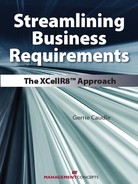Book Description
Effectively Define and Gather Your Business Requirements Today!Many programming systems today are designed and constructed before business requirements are completed and finalized. Without a proper foundation, these systems will eventually crumble. Streamlining Business Requirements: The XCellR8™ Approach provides project managers and business analysts with the foundation, principles, and steps needed to document business requirements in an accurate and efficient manner. Author Gerrie Caudle introduces the XCellR8™ approach, an analysis method used to gather business requirements in a structured, well-defined set of steps.
This book offers comprehensive framework needed to:
• Effectively analyze business requirements
• Properly identify business events
• Prepare for a requirements session
• Better understand the “big picture”
